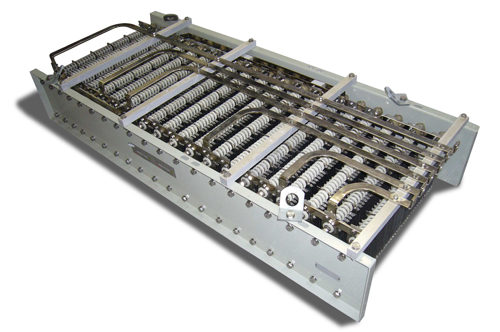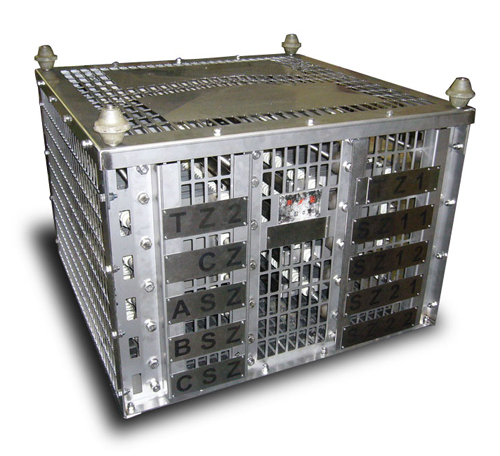- EMAIL: SALES@CRESSALL.COM
- • TEL: +44 (0) 116 273 3633
Cressall resistors have been used in transportation applications for more than sixty years and remain at the forefront of resistor technology.
Our customer demands are for ever higher braking powers to be safely dissipated from resistors which have to be compact, lightweight, easily maintained and with lifetimes to match the locomotives in which they are installed. Using our sophisticated 3D modelling and thermal simulation software Cressall engineers can rapidly offer optimized designs.
To prove our resistors once built, we have access to one of the best equipped test laboratories of any resistor manufacturer in the world, equipped with a 2 ton capacity 3-axis vibration table, a controlled power source of 1.5MW, and monitoring equipment that allows full validation of the resistor on test.
DYNAMIC BRAKING
The energies involved in stopping high speed trains are so great that disc brakes alone are unsuitable because of their very high wear rates and consequent maintenance and replacement costs.
Whenever possible regenerative braking is used. In this case the drive motors convert the kinetic energy of the train into electricity, which is fed back into the power supply and used elsewhere on the network.
If it cannot be absorbed by the system the energy may have to be dissipated with braking resistors. These braking resistors can be either mounted on the rail vehicle or as a fixed (trackside) installation connected to the third rail or overhead catenary via Automatic Assured Receptivity Unit (AARU) systems.
This is an effective means of controlling the regenerative energy as the braking resistors are non-wearing and integrate with the regenerative energy system.
When mounted on the rail vehicle design consideration must be given to the size and weight of the equipment, the temperature and direction of any hot air leaving the resistor as well as designing for the shock and vibration associated with a moving rail vehicle.
Installing resistors ‘trackside’ negates the requirements to use design rules associated with a moving vehicle however the equipment needs to be rated for higher powers and more frequent operation.
Cressall has extensive experience on supplying resistors for both applications.
CROWBAR RESISTORS
The two types of crowbar resistor, hard and soft, are both used in traction power supply circuits to deal with the effects of transient or longer lasting over-voltage conditions. The soft crowbar is pulsed to dissipate transient over-voltages; if these persist or worsen then the main breakers are opened and the system is short-circuited through the hard crowbar to absorb the stored energy.

CAPACITOR CHARGE/DISCHARGE RESISTORS
Modern solid state traction systems use capacitor/inductor filter circuits to decouple the traction power supply from the drives. These filters prevent surges and unwanted harmonics entering the supply. Resistors are used in these circuits to limit inrush currents to the capacitors during charging and also to discharge them safely when required.
MOTOR STARTING AND SPEED CONTROL RESISTORS
This was the traditional approach and uses resistors in traction systems to change the speed of the traction motors using contactor change control of the driving motors.
SNUBBER RESISTORS
Chopper and GTO/IGTB thyristor drives can generate very high back EMFs across the various solid state components. This is a result of the high frequency switching of the power to the traction motors, typically several hundred Hertz. These potentially damaging voltages are dissipated in parallel resistor/capacitor snubber circuits, for which a key requirement is low inductance. Expanded mesh/strip resistors are particularly suited to this requirement.
Construction: The basic construction will consist of banks of appropriately rated elements, supplied either for mounting within equipment cases, or as self-contained purpose-designed enclosures. All Cressall resistor elements are constructed from high grade stainless steel alloys, with mica and ceramic insulators, suitable for use in the most severe environments, and for roof or undercar mounting. Enclosures where supplied are in stainless steel.
Thermal shock: All Cressall traction designs will meet the shock and vibration requirements of IEC 60322. Expanded mesh/strip/HG resistors have the advantage that although the heated part of the element and the metal supporting it are formed from a single sheet, heat is kept out of the mountings, terminations and supporting insulators to a much greater extent than with other designs.
Cooling: The design of expanded mesh/strip elements ensures exceptionally effective heat transfer. Compact designs for both natural and forced air cooling are available.

